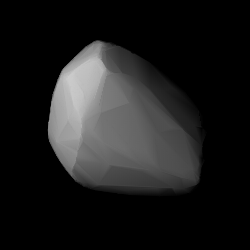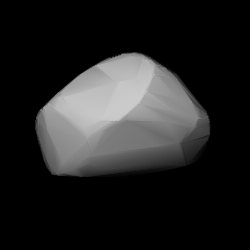Related Research Articles
6433 Enya, provisional designation 1978 WC, is a stony background asteroid from the inner regions of the asteroid belt, approximately 7 kilometers in diameter. It was discovered on 18 November 1978, by Czech astronomer Antonín Mrkos at the Kleť Observatory in the Czech Republic. It was named for Irish musician Enya.
5171 Augustesen, provisional designation 1987 SQ3, is a background asteroid and slow rotator from the inner regions of the asteroid belt, approximately 8 kilometers (5 miles) in diameter. It was discovered on 25 September 1987, by Danish astronomer Poul Jensen at the Brorfelde Observatory in Denmark. The suspected tumbler and presumed Vestian asteroid has an exceptionally slow rotation period of 480 hours and possibly an elongated shape. It was named after Danish astronomer Karl Augustesen.
6084 Bascom, provisional designation 1985 CT, is a binary Phocaea asteroid from the inner regions of the asteroid belt, approximately 6.3 kilometers in diameter. It was discovered on 12 February 1985, by American astronomer couple Carolyn and Eugene Shoemaker at Palomar Observatory in California. It is named after American geologist Florence Bascom. Its satellite measures approximately 2.3 kilometers and has an orbital period of 43.51 hours.
10830 Desforges, provisional designation 1993 UT6, is a background or Eunomian asteroid from the central regions of the asteroid belt, approximately 7 kilometers (4 miles) in diameter. It was discovered on 20 October 1993, by Belgian astronomer Eric Elst at the La Silla Observatory in northern Chile. The likely elongated S-type asteroid has a rotation period of 8.8 hours. It was named after French priest and aviation visionary Jacques Desforges.
9260 Edwardolson, provisional designation 1953 TA1, is a Florian binary asteroid from the inner regions of the asteroid belt, approximately 4.1 kilometers in diameter. It was discovered on 8 October 1953, by Indiana University during its Indiana Asteroid Program at Goethe Link Observatory in Brooklyn, Indiana, United States. It was named for American astronomer Edward Olson.
27270 Guidotti, provisional designation 2000 AY4, is a carbonaceous background asteroid from the inner regions of the asteroid belt, approximately 7 kilometers in diameter. It was discovered on 2 January 2000, by Italian astronomers Luciano Tesi and Alfredo Caronia at the Pistoia Mountains Astronomical Observatory in San Marcello Pistoiese, Italy. The asteroid was named after amateur astronomer Guido Guidotti.
3137 Horky, provisional designation 1982 SM1, is a background asteroid from the inner regions of the asteroid belt, approximately 7 kilometers (4.3 miles) in diameter. It was discovered on 16 September 1982, by Czech astronomer Antonín Mrkos at the Kleť Observatory in the Czech Republic. The likely stony asteroid was named for a hill near the Czech village of Horky.
5905 Johnson, provisional designation 1989 CJ1, is a Hungaria asteroid and synchronous binary system from the innermost regions of the asteroid belt, approximately 4 kilometers (2.5 miles) in diameter. It was discovered on 11 February 1989, by American astronomer Eleanor Helin at Palomar Observatory in California, United States. Its satellite measures approximately 1.6 km (1 mi) in diameter and orbits its primary every 21.8 hours. It was named after American astronomer and engineer Lindley N. Johnson.
2696 Magion, provisional designation 1980 HB, is a dark background asteroid and a slow rotator from the inner regions of the asteroid belt, approximately 21 kilometers in diameter. It was discovered on 16 April 1980, by Slovak astronomer Ladislav Brožek at the Kleť Observatory in former Czechoslovakia. The X-type asteroid has an ambiguous rotation period of 480 hours and is possibly a tumbler. It was named for the first Czechoslovak satellite, Magion 1, launched in 1978.

5026 Martes (prov. designation: 1987 QL1) is a carbonaceous asteroid from the inner region of the asteroid belt, approximately 9 kilometers (6 miles) in diameter. It was discovered on 22 August 1987, by Czech astronomer Antonín Mrkos at Kleť Observatory in the Czech Republic. It is named after the two weasel-like animal species: pine marten and beech marten.
11118 Modra, provisional designation 1996 PK, is a Flora asteroid of uncertain composition from the inner regions of the asteroid belt, approximately 5 kilometers in diameter.
1696 Nurmela, provisional designation 1939 FF, is a Baptistina asteroid from the inner regions of the asteroid belt, approximately 10 kilometers in diameter. It was discovered on 18 March 1939, by Finnish astronomer Yrjö Väisälä at Turku Observatory in Southwest Finland, and named after Finnish academician Tauno Nurmela. The possibly elongated asteroid has a rotation period of 3.15 hours.
13154 Petermrva, provisional designation 1995 RC, is a stony Flora asteroid from the inner regions of the asteroid belt, approximately 4.2 kilometers in diameter. It was discovered on 7 September 1995, by Slovak astronomers Adrián Galád and Alexander Pravda at the Modra Observatory in the Bratislava Region of Slovakia. The asteroid was named after Slovak amateur astronomer Peter Mrva.
1238 Predappia, provisional designation 1932 CA, is a dark Adeonian asteroid from the central regions of the asteroid belt, approximately 21 kilometers in diameter. It was discovered on 4 February 1932, by astronomer Luigi Volta at the Observatory of Turin in Pino Torinese, Italy. It was later named after the Italian village of Predappio.
1989 Tatry, provisional designation 1955 FG, is a carbonaceous Vestian asteroid and tumbling slow rotator from the inner regions of the asteroid belt, approximately 16 kilometers in diameter.

1276 Ucclia is a carbonaceous Alauda asteroid from the outer region of the asteroid belt, approximately 31 kilometers in diameter. It was discovered on 24 January 1933 by Belgian astronomer Eugène Delporte at the Royal Observatory of Belgium in Uccle. Two nights later, the body was independently discovered by Richard Schorr at Bergedorf Observatory in Hamburg, Germany. It was named for the Belgium city of Uccle and its discovering observatory.
3823 Yorii, provisional designation 1988 EC1, is a carbonaceous asteroid from the outer region of the asteroid belt, approximately 11 kilometers in diameter.
14968 Kubáček, provisional designation 1997 QG, is a stony background asteroid from the middle region of the asteroid belt, approximately 5 kilometers in diameter. The asteroid was discovered on 23 August 1997, by Slovak astronomers Adrián Galád and Alexander Pravda at Modra Observatory, Slovakia. It was named for Slovak astronomer Dalibor Kubáček.
2613 Plzeň, provisional designation 1979 QE, is an asteroid from the outer region of the asteroid belt, approximately 28 kilometers in diameter. It was discovered on 30 August 1979, by Czech astronomer Ladislav Brožek at the South Bohemian Kleť Observatory in the Czech Republic. It was later named for the Czech city of Plzeň.
2672 Písek, provisional designation 1979 KC, is a Eunomia asteroid from the central regions of the asteroid belt, approximately 25 kilometers in diameter. It was discovered on 31 May 1979, by Yugoslav astronomer Jaroslav Květoň at the Kleť Observatory in the Czech Republic. The likely elongated asteroid is a suspected tumbler and a slow rotator with an exceptionally long period of 831 hours. It was named after the Czech town of Písek.
References
- 1 2 3 4 "JPL Small-Body Database Browser: 6377 Cagney (1987 ML1)" (2017-05-05 last obs.). Jet Propulsion Laboratory . Retrieved 21 June 2017.
- 1 2 3 Schmadel, Lutz D. (2007). "(6377) Cagney". Dictionary of Minor Planet Names – (6377) Cagney. Springer Berlin Heidelberg. p. 528. doi:10.1007/978-3-540-29925-7_5830. ISBN 978-3-540-00238-3.
- 1 2 3 4 5 6 7 "LCDB Data for (6377) Cagney". Asteroid Lightcurve Database (LCDB). Retrieved 24 May 2016.
- 1 2 3 4 Nugent, C. R.; Mainzer, A.; Bauer, J.; Cutri, R. M.; Kramer, E. A.; Grav, T.; et al. (September 2016). "NEOWISE Reactivation Mission Year Two: Asteroid Diameters and Albedos". The Astronomical Journal. 152 (3): 12. arXiv: 1606.08923 . Bibcode:2016AJ....152...63N. doi: 10.3847/0004-6256/152/3/63 .
- 1 2 Galad, Adrian (April 2009). "Digest of Ten Lightcurves from Modra". The Minor Planet Bulletin. 36 (2): 42–44. Bibcode:2009MPBu...36...42G. ISSN 1052-8091 . Retrieved 24 May 2016.
- 1 2 3 Veres, Peter; Jedicke, Robert; Fitzsimmons, Alan; Denneau, Larry; Granvik, Mikael; Bolin, Bryce; et al. (November 2015). "Absolute magnitudes and slope parameters for 250,000 asteroids observed by Pan-STARRS PS1 - Preliminary results". Icarus. 261: 34–47. arXiv: 1506.00762 . Bibcode:2015Icar..261...34V. doi:10.1016/j.icarus.2015.08.007. S2CID 53493339 . Retrieved 24 May 2016.
- 1 2 "6377 Cagney (1987 ML1)". Minor Planet Center. Retrieved 1 March 2016.
- ↑ "MPC/MPO/MPS Archive". Minor Planet Center. Retrieved 24 May 2016.